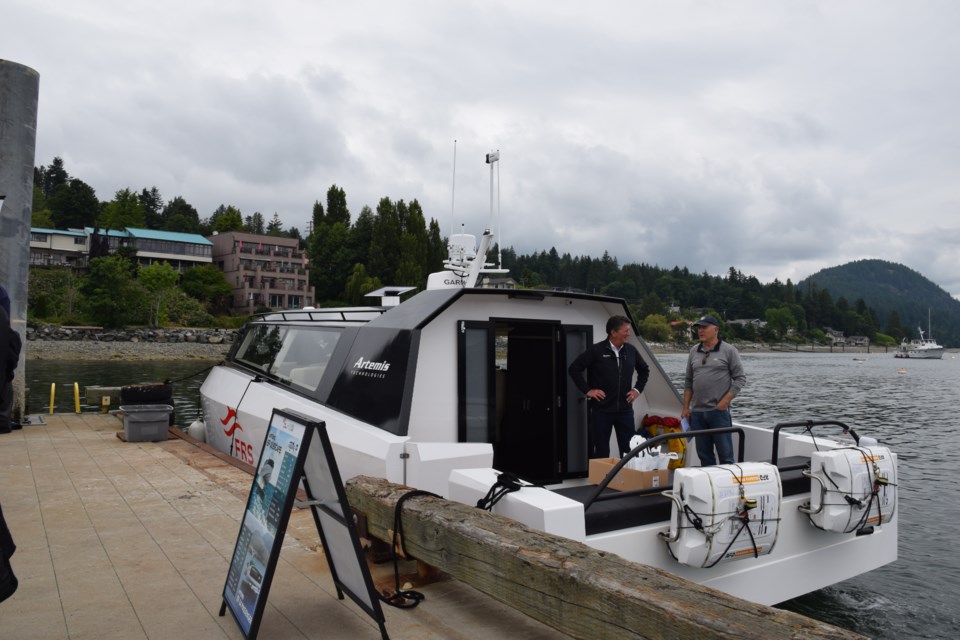There was a safety briefing but no need to secure seat belts for 12 lower Sunshine Coast-based guests on a brief and quiet June 22 electric ferry ride in the Gibsons harbour.
Local elected officials, business community members, advocates of alternative transportation and Coast Reporter were welcomed aboard Artemis Technologies' EF-12 Escape “luxury water taxi” by reps of that company, established seven years ago in Ireland. Also part of the afternoon event was Greenline Ferries, the firm focused on bringing a high-speed electric passenger ferry service to link Gibsons (and Bowen Island) with downtown Vancouver by 2027 and FRS Clipper, a company that operates ferries internationally, including a connection between Victoria and Washington State. The three are in discussions about the future of the local project.
A smooth and quiet cruise
With life vest locations identified and welcome words delivered, there was a brief and subdued electric motor wind up noise. The vessel started its acceleration (to about 14 knots), hull in the water. But within seconds, all on board could feel the watercraft elevate slightly to cruise on its rear, wing-like hydrofoil, a design feature that decreases drag, allowing it to achieve greater speeds.
The splashing sound of water on the hull then dissipated and the ride was quiet enough for passengers to share conversations without raised voices and smooth enough to move about with ease. Looking off the rear deck, Artemis’ North American senior vice-president Carl Wegener drew passengers’ attention to the ”minimal” wake that was being produced as the 12,000 kilogram vessel moved along at about 28 knots.
The EF-12 that was in Gibsons for the demonstration won’t be the model used for proposed local passenger services. Greenline’s founder, Callum Campbell told Coast Reporter the firms hosting the event weren’t testing that particular vessel but its range of debris detection technology, to see its fit with the water conditions (and hazards) encountered in this area of the Salish Sea. Earlier in the week, the team conducted test runs with guests in Victoria, Vancouver and Bowen Island. All went well in Campbell’s opinion. He said the following day there would be a trip along the coast to Squamish.
Campbell said he likes the idea of incorporating hydrofoil technology into the eventual design for the potential lower Sunshine Coast service. “It is a really comfortable ride. It’s funny, people expect fireworks when you lift off onto the foil, but it is really quite anticlimactic. It’s just a quiet electric ferry ride that gets a little quieter once you lose the noise of the water on the hull, and then you are just zipping along with almost no wake whatsoever.”
As the waters from the Lions Gate bridge into downtown Vancouver are what Campbell called “a slow zone” because of issues related to watercraft wakes and other concerns, hydrofoil vessels might be preferred for a ferry service connecting Gibsons and Coal Harbour. He stated an interest in “catamarans with hydrofoils,” noting that the combination can be “so much more efficient, use a fraction of the power” of other designs. “You can go faster, you can go farther and you can deliver more trips per day,” he summarized.
'Lots of different projects under way'
Along with exploring vessel technologies, Campbell said Greenline has “a lot of different projects under way right now” in relation to the electric ferry service. He stated work continues on the charge barge project, the infrastructure needed to refuel the vessels in port.
“We’re engaging with the Gibsons Landing Harbour Authority on a location for the charge barge. We have a nominal design and looked at (positioning it) outside the breakwater, but we’ll be seeing if there are other locations.”
Along with siting options, other potential charge barge users, such as Harbour Air, which is working on an electric-powered float plane project, are being consulted, he added.
In addition, Campbell said Greenline has reached out to BC Transit about local service adjustments that could support the ground transportation for the users of the potential new ferry service, and that the company continues to update Gibsons town council as the work progresses.
Another component under development is the business relationship involving Greenline, FRS Clipper and Artemis. He said there is currently a memorandum of understanding and that may progress in the future.
FRS Clipper’s board chair (and former BC Ferries CEO) Mark Collins, on hand for the Gibsons' demo ride told passengers in his pre-departure remarks, “What we see here is the opportunity to have a sustainable ferry system that doesn’t require government funding… a business to be here through thick and thin for the people of the Coast… subsidies come and go, but we intend to be here for the long term."
“Having FRS Clipper take a real strong interest in the business case is really important for us, moving forward our business vision,” Campbell stated.
Asked about having the service running in 2027, Campbell said, “We’ve never had more momentum than we have right now, and I feel great about it. There’s a broad interest in ferries, people want to talk and take action.”



